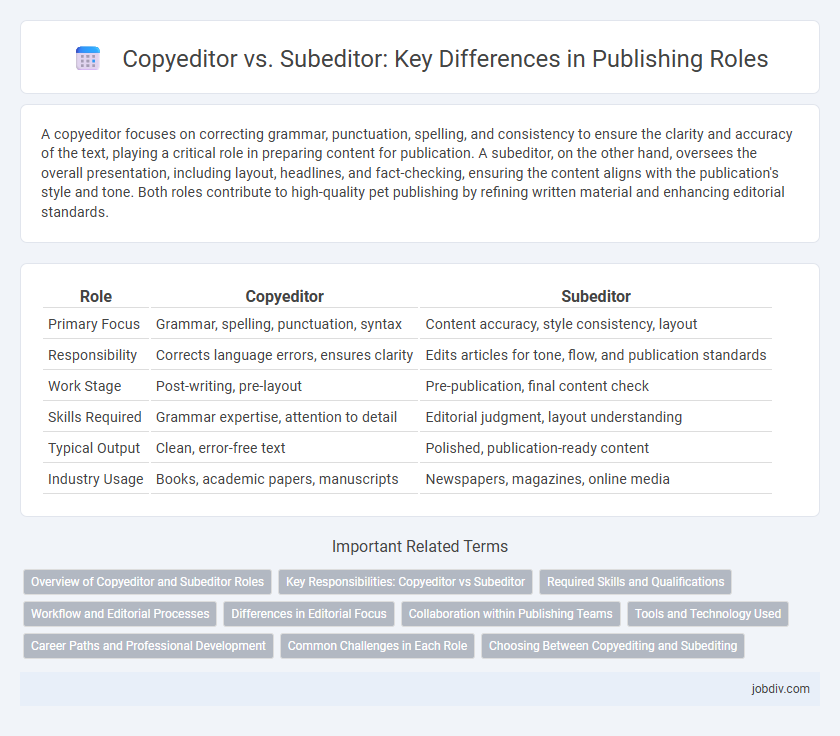A copyeditor focuses on correcting grammar, punctuation, spelling, and consistency to ensure the clarity and accuracy of the text, playing a critical role in preparing content for publication. A subeditor, on the other hand, oversees the overall presentation, including layout, headlines, and fact-checking, ensuring the content aligns with the publication's style and tone. Both roles contribute to high-quality pet publishing by refining written material and enhancing editorial standards.
Table of Comparison
| Role | Copyeditor | Subeditor |
|---|---|---|
| Primary Focus | Grammar, spelling, punctuation, syntax | Content accuracy, style consistency, layout |
| Responsibility | Corrects language errors, ensures clarity | Edits articles for tone, flow, and publication standards |
| Work Stage | Post-writing, pre-layout | Pre-publication, final content check |
| Skills Required | Grammar expertise, attention to detail | Editorial judgment, layout understanding |
| Typical Output | Clean, error-free text | Polished, publication-ready content |
| Industry Usage | Books, academic papers, manuscripts | Newspapers, magazines, online media |
Overview of Copyeditor and Subeditor Roles
Copyeditors focus on correcting grammar, punctuation, and spelling errors while ensuring consistency in style and tone across a manuscript. Subeditors primarily work on articles in newspapers or magazines, refining headlines, rewriting content for clarity, and ensuring the layout aligns with editorial standards. Both roles are essential in publishing for maintaining accuracy, coherence, and adherence to the publication's voice.
Key Responsibilities: Copyeditor vs Subeditor
A copyeditor primarily focuses on refining grammar, punctuation, style consistency, and factual accuracy within manuscripts to ensure clarity and readability. In contrast, a subeditor oversees the overall structure, layout, and coherence of articles or pages, often adapting content for publication standards and audience engagement. Both roles are critical in the publishing process, but copyeditors emphasize textual precision while subeditors manage editorial cohesion and presentation.
Required Skills and Qualifications
Copyeditors require strong attention to detail, expertise in grammar, punctuation, and style guides, and proficiency in language clarity and consistency to ensure text accuracy and readability. Subeditors need advanced skills in headline writing, layout design, fact-checking, and often possess familiarity with content management systems and editorial software. Both roles typically demand a background in journalism, communications, or English, with copyeditors focusing on textual precision and subeditors overseeing overall content presentation and alignment with publication standards.
Workflow and Editorial Processes
Copyeditors focus on refining text for grammar, style, clarity, and consistency, ensuring manuscripts meet publication standards before layout. Subeditors handle content structuring, headline creation, and fact-checking, coordinating with designers and writers to finalize the editorial layout. The workflow begins with the copyeditor's language polishing, followed by the subeditor's role in enhancing readability and visual presentation within the publication's editorial process.
Differences in Editorial Focus
Copyeditors specialize in refining language accuracy, grammar, punctuation, and style consistency to ensure clarity and correctness in the text. Subeditors focus on tailoring content for publication by optimizing headlines, captions, layout, and maintaining the overall flow and coherence of articles. The primary editorial difference lies in copyeditors' micro-level attention to linguistic detail versus subeditors' macro-level responsibility for presentation and reader engagement.
Collaboration within Publishing Teams
Copyeditors and subeditors collaborate closely within publishing teams to ensure clarity, accuracy, and coherence in the final manuscript. Copyeditors focus on grammar, spelling, and style consistency, while subeditors refine structure, headlines, and overall flow to enhance reader engagement. Their coordinated efforts streamline the editorial process, contributing to polished, professional publications that meet both editorial standards and audience expectations.
Tools and Technology Used
Copyeditors primarily use advanced grammar and style-checking software such as Grammarly, ProWritingAid, and Adobe InCopy to ensure text accuracy and consistency. Subeditors often rely on content management systems (CMS) like WordPress or Joomla, alongside layout tools like Adobe InDesign, to format articles and optimize them for publication. Both roles increasingly incorporate AI-powered tools for fact-checking, plagiarism detection, and real-time collaboration in digital publishing environments.
Career Paths and Professional Development
Copyeditors specialize in refining grammar, syntax, and style consistency, building expertise that often leads to senior editorial roles or specialization in technical, academic, or literary fields. Subeditors, mainly in journalism and magazine publishing, develop skills in headline writing, fact-checking, and layout coordination, paving the way toward becoming chief subeditors or editorial managers. Both career paths offer opportunities for professional development through mastery of digital tools, industry standards, and content strategy, enhancing editorial precision and leadership potential.
Common Challenges in Each Role
Copyeditors often face challenges related to ensuring grammatical accuracy, maintaining consistent style, and catching typographical errors while adhering to tight deadlines. Subeditors struggle with balancing headline clarity, layout constraints, and fact-checking under pressure to streamline content for publication. Both roles require meticulous attention to detail and effective communication with writers and designers to produce polished, error-free text.
Choosing Between Copyediting and Subediting
Choosing between copyediting and subediting depends on the specific needs of the publication, with copyediting focusing on grammar, style consistency, and factual accuracy while subediting emphasizes layout, headline creation, and ensuring the story fits the publication's tone. Copyeditors refine text to eliminate errors and improve readability, whereas subeditors manage the visual presentation and editorial flow to engage readers effectively. Understanding these distinct roles helps publishers allocate resources efficiently, ensuring both content quality and design coherence across print and digital platforms.
Copyeditor vs Subeditor Infographic

 jobdiv.com
jobdiv.com